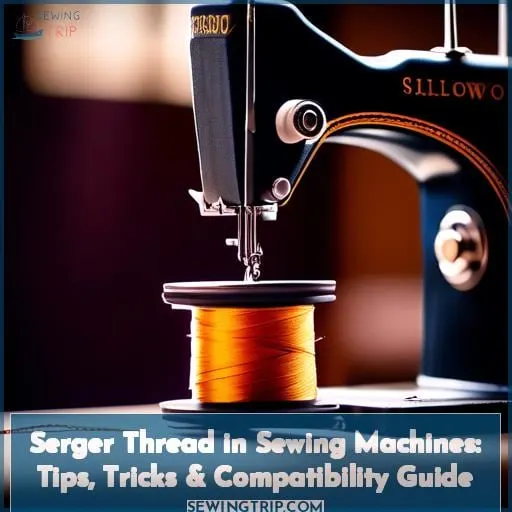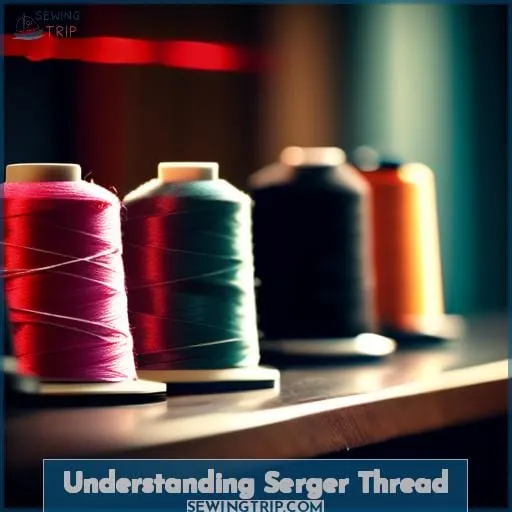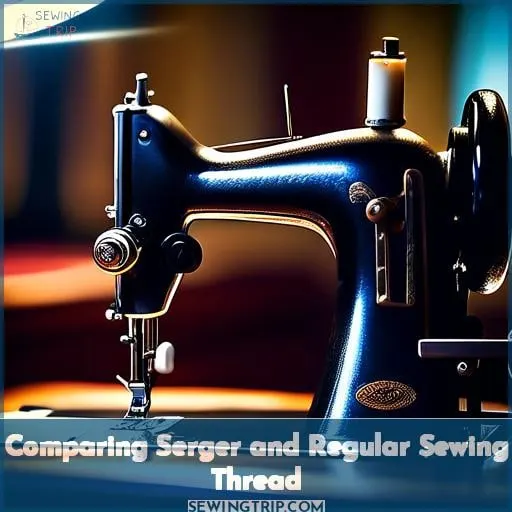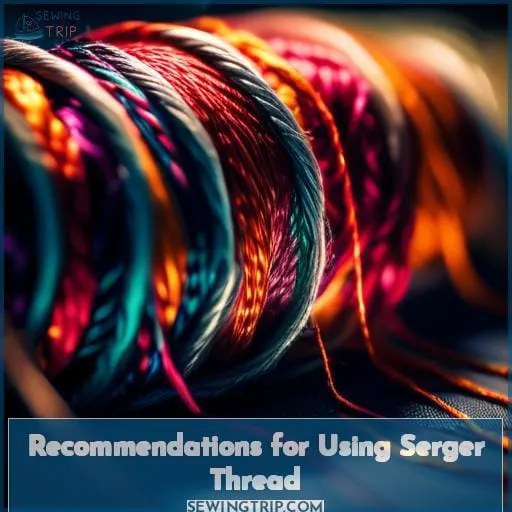This site is supported by our readers. We may earn a commission, at no cost to you, if you purchase through links.
 Curious if you can swap out regular thread for serger thread in your sewing machine? You’re not alone.
Curious if you can swap out regular thread for serger thread in your sewing machine? You’re not alone.
This guide dives into the nitty-gritty of using serger thread for standard sewing tasks. We’ll explore thread strength, tension adjustments, and compatibility, providing you with practical tips and thorough tests.
Whether you’re looking to economize or simply experiment, you’ll find out how to make serger thread work for you and your projects.
Table Of Contents
Key Takeaways
- Serger thread is generally finer and may not be as strong as regular sewing thread, which could lead to easier tearing in straight-stitched seams on a sewing machine.
- Using a spool holder can help prevent tension issues when using serger thread in a sewing machine, ensuring smoother stitching and reducing the risk of breakage.
- The appearance and performance of stitches made with serger thread can differ from those made with regular thread, potentially resulting in uneven seam strength and a bumpy stitch appearance.
- It’s important to adjust the sewing machine’s tension settings carefully when using serger thread and to test on scrap fabric first to ensure the desired outcome and avoid seam ripping incidents.
Can I Use Serger Thread in My Sewing Machine
Yes, you can use serger thread in your sewing machine, but it may require modifications like a thread stand and could lead to tension issues or weaker seams compared to regular thread.
Understanding Serger Thread
Serger thread’s strength and composition differ from that of regular sewing thread. It is often lighter and sometimes two-ply. If you’re considering using it in your sewing machine, be mindful of potential tension issues that could arise.
Thread Strength and Composition
When venturing into the world of sewing, you’ll find that serger thread and your trusty sewing machine mightn’t always see eye to eye.
- Serger thread is typically the lightweight contender, often two-ply, compared to the heavyweight champ, three-ply regular thread.
- Thread size matters: serger thread is usually finer (T-27) than its all-purpose counterpart (T-34).
- Watch for thread tension tiffs; serger thread may demand a bit more finesse.
Tension Issues With Serger Thread
After diving into the world of thread strength, let’s tackle the knotty issue of tension adjustments when using serger thread in your sewing machine. You’ve probably noticed that serger thread can be a bit of a wild card, leading to unexpected thread breakage or seam quality woes.
But fear not! With a bit of tweaking, you can ensure your fabric strength isn’t compromised.
| Challenge | Solution |
|---|---|
| Thread breakage | Lower the tension slightly |
| Uneven seam strength | Use a spool holder |
| Tension issues | Adjust tension discs carefully |
| Seam ripping incidents | Test on scrap fabric first |
Comparing Serger and Regular Sewing Thread
When comparing serger and regular sewing thread, it’s crucial to note the visual and performance differences in the resulting stitches.
Strength tests reveal that while serger thread may appear robust in serged seams, it can tear more easily in straight-stitched seams on a sewing machine.
Visual Differences in Stitches
When you swap your sewing machine’s regular thread for serger thread, it’s like trading your sedan for a sports car; both get you there, but the ride feels different.
Maxi-lock and Surelock serger threads might make your machine purr or grumble, depending on its mood.
Unlike the consistent highway of specialty sewing threads, serger thread can take you on a scenic, albeit bumpy, route.
Strength Test Results
After diving into the visual quirks of serger versus regular sewing thread, let’s tackle the strength test arena.
Here’s the scoop: fabric might wave the white flag and tear before serger thread throws in the towel.
Between serger and regular threads, it’s a tight race, but compatibility checks can save the day.
Adjusting Your Sewing Machine for Serger Thread
To accommodate serger thread in your sewing machine, you’ll need to use a spool holder to prevent tension issues.
Make sure to adjust your machine’s tension settings carefully to ensure smooth stitching and avoid breakage.
Using a Spool Holder
Diving into the world of sewing with serger thread? Grab a spool holder! This nifty gadget is your golden ticket to smooth sailing.
It tackles thread tension tantrums and ensures your serger thread plays nice with your sewing machine.
Think of it as a peacekeeper, bridging the gap between serger thread strength and sewing finesse.
Addressing Tension Adjustments
When using serger thread in your sewing machine, it’s like taming a wild stallion; you’ve got to get the tension settings just right.
Ensure bobbin compatibility, and choose the correct stitch type for your fabric weight.
Quality counts, so pick a thread that won’t let you down mid-gallop.
Recommendations for Using Serger Thread
When considering serger thread for your sewing machine, it’s crucial to assess the specific needs of your project.
Determine if the strength and texture of serger thread align with your project’s requirements to ensure optimal results.
When to Choose Serger Thread
After tweaking your sewing machine with a spool holder to accommodate serger thread, let’s dive into when to opt for it.
Serger thread shines in cost and durability, making it a savvy choice for bulk projects where finesse isn’t the star.
For upholstery, cotton creations, or jeans top stitching, stick with Gutermann or all-purpose thread to ensure your masterpiece withstands the test of time.
Project Suitability
When deciding if serger thread’s right for your project, consider these points:
- Suitability for specific fabrics: Will it hold up?
- Durability for heavy fabrics: Don’t let a tough textile bully your thread!
- Color matching: Ensure your thread complements your fabric.
- Cost comparison: Serger thread can be a wallet-friendly option.
- Availability: Check your local store’s stash—don’t get stranded!
Experimenting With Different Threads
To determine if serger thread is right for your sewing machine, you’ll need to conduct tests on various fabrics and seams.
Assessing the strength and appearance of these tests will guide you in selecting the appropriate thread for your projects.
Testing for Compatibility
Dive into the fabric fray with a bit of thread comparison savvy.
When testing compatibility, think of your sewing machine as a picky eater—some threads just won’t sit well.
A strength evaluation can save you from a seam strength disaster.
So, pit serger against sewing thread in a stitch-off; may the strongest thread triumph!
Considering Seam Strength
When considering seam strength, it’s like walking a tightrope between durability and flexibility.
- Seam Durability: Thicker threads might seem like the Hercules of threads, but they can be overkill, making your seams stiffer than a board.
- Fabric Tearing: A seam stronger than the fabric is a recipe for disaster. Aim for balance to avoid your fabric waving the white flag.
- Thread Thickness & Stretchiness: Like Goldilocks, find the thread that’s just right. Too thick and your pattern visibility goes kaput; too stretchy and your seams might do the limbo under stress.
Frequently Asked Questions (FAQs)
Does serger thread colorfastness differ from regular?
Serger thread generally has a high level of colorfastness. Similar to regular thread, this ensures your stitches stay true to color through washes and wear.
Can serger thread cause machine warranty issues?
Using the wrong thread, like serger thread, in your sewing machine could void the warranty.
Is serger thread suitable for hand sewing?
Sure, you can use serger thread for hand sewing. However, it’s a bit like bringing a plastic spork to a steak dinner.
How does humidity affect serger thread tension?
As the saying goes, Too much of a good thing can be bad, and that’s true for serger thread tension in humidity.
High humidity can cause thread to absorb moisture, leading to tension issues and breakage.
Will serger thread work for buttonholes?
You can use serger thread for buttonholes, but it’s a bit like bringing a knife to a gunfight.
It’ll do the job, but for top-notch, durable buttonholes, stick with stronger, regular sewing thread.
Conclusion
So, you’ve dared to ask if serger thread can cozy up in your sewing machine for your next crafting escapade.
Fear not, adventurous stitcher! This guide has armed you with the know-how to make serger thread your sewing ally.
From adjusting tension to choosing the right projects, you’re now equipped to experiment with confidence.
Embrace the versatility of serger thread and watch your sewing projects transform.










